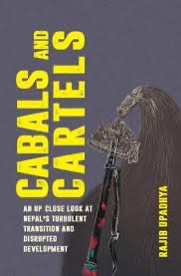Books
A lament for Nepal from a vantage point
A former World Bank employee dwells on the country’s problems and offers glimpses into workings of the donor community but loses focus while also talking of the political transition.
Manesh Shrestha
There are a number of parallels between the first Girija Prasad Koirala administration and the present Khadga Prasad Oli one.
Both came to power after the country got a new constitution—the former after Nepal adopted multi-party democracy and the latter after the country abolished the monarchy and became a federal republic. Without being pedantic, it could be said both won elections with a comfortable majority. Soon after coming to power, both faced accusations of backstabbing from within party colleagues.
A strong-willed Koirala dissolved parliament when his position in the Nepali Congress party became untenable, while an equally dogged Oli lately threatened to break his Nepal Communist Party. Nepali politics continued to pay for Koirala’s misadventures for almost a quarter of a century, while it remains to be seen whether Oli’s determination to hang on to power will have such historical consequences.
In Rajib Upadhya’s Cabals and Cartels: An Up Close Look at Nepal’s Turbulent Transition and Disrupted Development, there is an analysis, borrowing from an unpublished World Bank report “grandly” titled Politic Economy Reform in Nepal, of the fallout of Koirala’s realpolitik gamble in 1994.
Politicians calculate whether their policies are politically beneficial and this calculation is more important than anything else including whether they benefit the people they rule over. By extension, this would mean political expediency would take over reform or any other policy decisions. The insight would explain why in Nepal politics is so pervasive and the welfare of the people is never a priority for our leaders.
As an employee of the World Bank office in Kathmandu for 23 years, Upadhya provides much inside dope in the book on the workings of the World Bank and the larger donor community in the country. He tells how in the late 1990s in order to put pressure on the government to act over the almost insolvent situation of two state-owned banks–Nepal Bank Limited and Rastriya Banijya Bank—it leaked findings of its investigations to journalists, how a particular student protests over the hike in petroleum products prices subsided after the Bank invited Gagan Thapa and other student leaders for a talk to explain why the rise was beyond Nepal government’s control, how the Supreme Court overturned its earlier decision on the suspension of Nepal Rastra Bank Governor Bijay Bhattarai over alleged corruption after then finance minister Baburam Bhattarai directed his staff to distribute among the court’s justices the findings of the Bank’s report on the case, and how the National Reconstruction Authority was modelled on the Pakistan Earthquake Reconstruction and Rehabilitation Authority at the suggestion of donors.
The World Bank also wades into the murky waters of Nepali politics. It involved itself in “prolific inventiveness” when King Gyanendra was holding democracy hostage and the government of Sher Bahadur Deuba was intent on “rebuilding the state’s political legitimacy” in the midst of the Maoist war. In order to help bring about “dramatically tangible improvements in public service delivery”, the Bank led a group of donors to step in when there were “funding and knowledge gaps” in the dubiously legitimate government’s efforts.
Later when Gyanendra took direct control of the government, an “enamoured” Praful Patel, the World Bank’s vice president for South Asia, after an audience with the king, wrote “to his entire staff extolling King Gyanendra’s virtues and arguing why the World Bank should be ready to do business with his government”.
Cabals and Cartels is divided into two parts.
The first part—Turbulent Transition—begins with the royal massacre of 2001 and ends with the promulgation of the new constitution in 2015.
There have been enough books on Nepal’s transition to a republic and nothing stands out in this one other than nuggets about the World Bank’s well-intentioned efforts in aiding the transition like inviting Ashraf Ghani, the present president of Afghanistan, as a consultant for the donor community, to help it understand Nepal’s needs going forward. True to form, the consultant told the donors exactly what they wanted to hear. Here’s a gem from Ghani: “The focus of development must be on Nepali citizens and requires very careful thought as to exactly what is being delivered into which groups. The discourse on inclusion needs to transition from highly abstract rhetoric to a problem-solving approach through a clear knowledge from which to work and focus on areas where progress is most possible.”
The first part also contains a generous sprinkling of name dropping. In the second chapter, which narrates an event three months before the royal massacre, Crown Prince Dipendra addresses the author “dai” (elder brother) because they went to the same school. He had the good fortune to listen to Narendra Modi, the Indian prime minister address the Constituent Assembly in the flesh because his “friend” Manohar Bhattarai the secretary general of the Assembly provided him with a pass. Arzu Deuba calls him to apologise for her husband’s drunken outburst at him at a party the previous evening. We learn his usual haunts included Red Onion Bar at Hotel Radisson where he heard of the royal massacre and the sauna at Hotel Yak and Yeti where he found himself alone on May 12, 2015 during the 7.3 magnitude aftershock two days after the bigger earthquake of May 10.
The shorter second part—Disrupted Development—talks about the seemingly impossible challenges Nepal faces for its progress. The cabals in the book title refers to the political parties and they “understand that a public expenditure system captured and enfeebled, never to attempt transparency nor embrace fiscal logic, will entitle them to raid development resources forever”. The cartels “have flourished across all sectors of the Nepali economy” and are hand in glove with the cabals to raid state coffers as the state has “all but abdicated its regulatory obligations in most sectors”. In such a situation there is little the citizen can hope for.
The politics and business nexus is best exemplified by an incident the author relates. A Chinese man, representing the interest of an airline on the Kathmandu-Lhasa sector mistook a friend of the author’s to be managing director of Nepal Airlines Corporation and brazenly offered him a “generous bribe” if he made sure there were no Nepal Airlines Kathmandu-Lhasa flights.

Instead of cabals Upadhyay blames the electoral system and the election costs which the businessmen are only too happy to provide. Instead of blaming the cartels, he says they don’t have a choice but to grease hands of those in high office given the “political and social conditions”. The donors meanwhile ride along “throwing good money after bad” after devising “gratuitous ways to reward the government even for elementary tasks that any government anywhere should be performing on its own”. The show goes on.
For 260 pages of the main text, Cabals and Cartels has 34 chapters and this reflects on the lack of planning in writing the book. Themes are not sufficiently developed and the focus is unclear–whether it is the political transition, the political economy or whether the author is talking about himself. The book is also poorly edited. Except for some revelations on the workings of the World Bank and by extension that of the donor community in Nepal, there is nothing very much that is new.
The last chapter, the longest in the book, where, out of the blue, Upadhya talks of his illustrious lineage, could be developed into a separate book to talk about an era bygone and how, to borrow the words of the president of Afghanistan, “the past is still very much present in Nepal”. Or how it isn’t, for that matter.
Upadhya does offer the customary hope in this book—in the media, in sections of the bureaucracy, and in the new federal structure where empowered communities could come between the cabals and the cartels. But Oli and company has, for reasons of political expediency, hijacked federalism. Whether that will be a historical opportunity missed a la Koirala remains to be seen.
Book: Cabals and Cartels: An Up Close Look at Nepal’s Turbulent Transition and Disrupted Development (Fine Print)
Pages: 282+xii
Price: Rs720




 5.05°C Kathmandu
5.05°C Kathmandu











